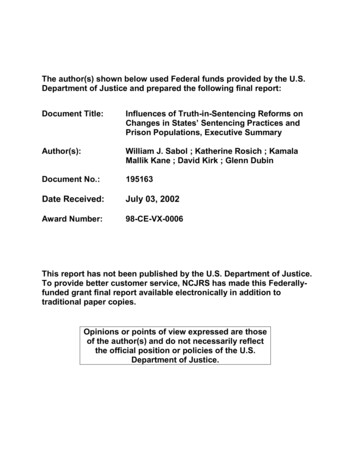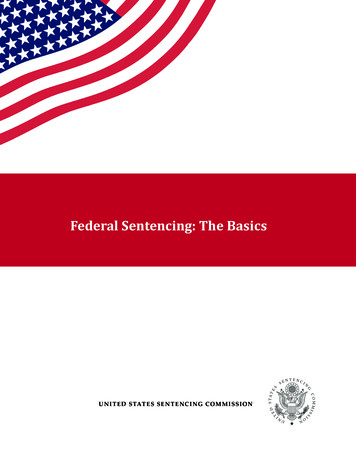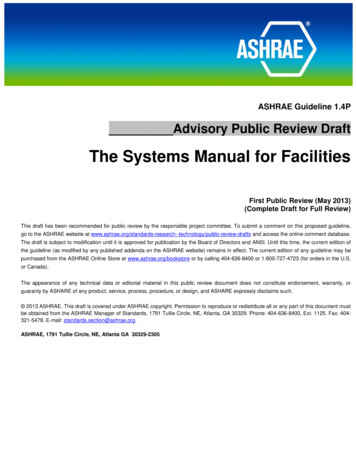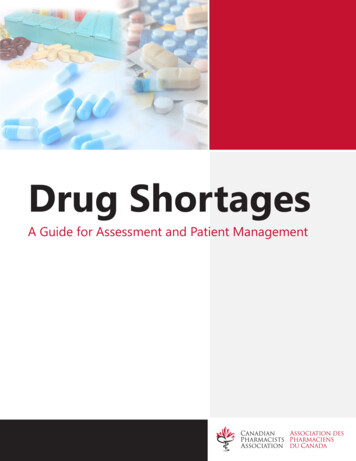
Transcription
Drug OffencesDefinitive GuidelineDEFINITIVE GUIDELINEFor reference only.Please refer to the guideline(s)on the Sentencing Council website:www.sentencingcouncil.org.uk
Drug OffencesDefinitive Guideline 1For referenceonly.Please refer to the guideline(s)on the Sentencing Council cability of guidelineFraudulent evasion of a prohibition by bringing intoor taking out of the UK a controlled drugMisuse of Drugs Act 1971 (section 3) andCustoms and Excise Management Act 1979 (section 170(2)) 3Supplying or offering to supply a controlled drugMisuse of Drugs Act 1971 (section 4(3)) andPossession of a controlled drug with intentto supply it to another (section 5(3))9Production of a controlled drugMisuse of Drugs Act 1971 (section 4(2)(a) or (b)) andCultivation of cannabis plant (section 6(2))17Permitting premises to be usedMisuse of Drugs Act 1971 (section 8)23Possession of a controlled drugMisuse of Drugs Act 1971 (section 5(2))29Annex: Fine bands and community orders33 Crown copyright 2012You may re-use this information (not including logos) free of charge in any format or medium, under the terms ofthe Open Government Licence. To view this licence, visit ence/or email: psi@nationalarchives.gsi.gov.uk
2 Drug Offences Definitive GuidelineFor reference only.Please refer to the guideline(s)on the Sentencing Council website:www.sentencingcouncil.org.ukApplicability of guidelineIn accordance with section 120 of theCoroners and Justice Act 2009, theSentencing Council issues this definitiveguideline. It applies to all offenders aged18 and older, who are sentenced on or after27 February 2012, regardless of the date ofthe offence.Section 125(1) of the Coroners and Justice Act2009 provides that when sentencing offencescommitted after 6 April 2010:“Every court –(a) must, in sentencing an offender, follow anysentencing guideline which is relevant to theoffender’s case, and(b) must, in exercising any other function relatingto the sentencing of offenders, follow anysentencing guidelines which are relevant tothe exercise of the function,unless the court is satisfied that it would becontrary to the interests of justice to do so.”This guideline applies only to offenders aged 18and older. General principles to be considered inthe sentencing of youths are in the SentencingGuidelines Council’s definitive guideline,Overarching Principles – Sentencing Youths.Structure, ranges and starting pointsFor the purposes of section 125(3) – (4) of theCoroners and Justice Act 2009, the guidelinespecifies offence ranges – the range ofsentences appropriate for each type of offence.Within each offence, the Council has specifiedthree categories which reflect varying degreesof seriousness. The offence range is split intocategory ranges – sentences appropriate foreach level of seriousness. The Council has alsoidentified a starting point within each category.Starting points define the position within acategory range from which to start calculatingthe provisional sentence. Starting points applyto all offences within the correspondingcategory and are applicable to all offenders,in all cases. Once the starting point isestablished, the court should consider furtheraggravating and mitigating factors and previousconvictions so as to adjust the sentence withinthe range. Starting points and ranges apply toall offenders, whether they have pleaded guiltyor been convicted after trial. Credit for a guiltyplea is taken into consideration only at stepfour in the decision making process, after theappropriate sentence has been identified.Information on community orders and finebands is set out in the annex at page 33.
Fraudulent evasion of a prohibitionby bringing into or taking out of theUK a controlled drugMisuse of Drugs Act 1971 (section 3)Customs and Excise Management Act 1979(section 170(2))Triable either way unless the defendant could receive the minimumsentence of seven years for a third drug trafficking offence undersection 110 Powers of Criminal Courts (Sentencing) Act 2000 inwhich case the offence is triable only on indictment.Class AMaximum: Life imprisonmentOffence range: 3 years 6 months’ – 16 years’ custodyA class A offence is a drug trafficking offence for the purposeof imposing a minimum sentence under section 110 Powers ofCriminal Courts (Sentencing) Act 2000Class BMaximum: 14 years’ custody and/or unlimited fineOffence range: 12 weeks’ – 10 years’ custodyClass CMaximum: 14 years’ custody and/or unlimited fineOffence range: Community order – 8 years’ custodyIMPORTATIONDrug OffencesDefinitive Guideline 3For referenceonly.Please refer to the guideline(s)on the Sentencing Council website:www.sentencingcouncil.org.uk
IMPORTATION4 Drug Offences Definitive GuidelineFor reference only.Please refer to the guideline(s)on the Sentencing Council website:www.sentencingcouncil.org.ukSTEP ONEDetermining the offence categoryThe court should determine the offender’s culpability (role) and the harm caused (quantity) with referenceto the tables below.In assessing culpability, the sentencer should weigh up all the factors of the case to determine role.Where there are characteristics present which fall under different role categories, the court shouldbalance these characteristics to reach a fair assessment of the offender’s culpability.In assessing harm, quantity is determined by the weight of the product. Purity is not taken into accountat step 1 but is dealt with at step 2.Where the operation is on the most serious and commercial scale, involving a quantity of drugs significantlyhigher than category 1, sentences of 20 years and above may be appropriate, depending on the role of theoffender.Culpability demonstrated by offender’s roleOne or more of these characteristics may demonstratethe offender’s role. These lists are not exhaustive.Category of harmIndicative quantity of drug concerned (upon which thestarting point is based):LEADING role: directing or organising buying and selling on acommercial scale; substantial links to, and influence on, others in a chain; close links to original source; expectation of substantial financial gain; uses business as cover; abuses a position of trust or responsibility.Category 1 heroin, cocaine – 5kg; ecstasy – 10,000 tablets; LSD – 250,000 squares; amphetamine – 20kg; cannabis – 200kg; ketamine – 5kg.SIGNIFICANT role: operational or management function within a chain; involves others in the operation whether by pressure,influence, intimidation or reward; motivated by financial or other advantage, whether ornot operating alone; some awareness and understanding of scale ofoperation.LESSER role: performs a limited function under direction; engaged by pressure, coercion, intimidation; involvement through naivety/exploitation; no influence on those above in a chain; very little, if any, awareness or understanding of thescale of operation; if own operation, solely for own use (consideringreasonableness of account in all the circumstances).Category 2 heroin, cocaine – 1kg; ecstasy – 2,000 tablets; LSD – 25,000 squares; amphetamine – 4kg; cannabis – 40kg; ketamine – 1kg.Category 3 heroin, cocaine – 150g; ecstasy – 300 tablets; LSD – 2,500 squares; amphetamine – 750g; cannabis – 6kg; ketamine – 150g.Category 4 heroin, cocaine – 5g; ecstasy – 20 tablets; LSD – 170 squares; amphetamine – 20g; cannabis – 100g; ketamine – 5g.
STEP TWOStarting point and category rangeHaving determined the category, the court should use the corresponding starting point to reach a sentencewithin the category range below. The starting point applies to all offenders irrespective of plea or previousconvictions. The court should then consider further adjustment within the category range for aggravating ormitigating features, set out over the page. In cases where the offender is regarded as being at the very topof the ‘leading’ role it may be justifiable for the court to depart from the guideline.Where the defendant is dependent on or has a propensity to misuse drugs and there is sufficient prospectof success, a community order with a drug rehabilitation requirement under section 209 of the CriminalJustice Act 2003 can be a proper alternative to a short or moderate length custodial sentence.For class A cases, section 110 of the Powers of Criminal Courts (Sentencing) Act 2000 provides thata court should impose a minimum sentence of at least seven years’ imprisonment for a third classA trafficking offence except where the court is of the opinion that there are particular circumstanceswhich (a) relate to any of the offences or to the offender; and (b) would make it unjust to do so in allthe circumstances.CLASS ACategory 1Category 2Category 3Category 4Leading roleSignificant roleLesser roleStarting point14 years’ custodyStarting point10 years’ custodyStarting point8 years’ custodyCategory range12 – 16 years’ custodyCategory range9 – 12 years’ custodyCategory range6 – 9 years’ custodyStarting point11 years’ custodyStarting point8 years’ custodyStarting point6 years’ custodyCategory range9 – 13 years’custodyCategory range6 years 6 months’ –10 years’ custodyCategory range5 – 7 years’custodyStarting point8 years 6 months’ custodyStarting point6 years’ custodyStarting point4 years 6 months’ custodyCategory range6 years 6 months’ –10 years’ custodyCategory range5 – 7 years’custodyCategory range3 years 6 months’ –5 years’ custodyWhere the quantity falls below the indicative amount set out for category 4 on the previous page, firstidentify the role for the importation offence, then refer to the starting point and ranges for possessionor supply offences, depending on intent.Where the quantity is significantly larger than the indicative amounts for category 4 but belowcategory 3 amounts, refer to the category 3 ranges above.IMPORTATIONDrug OffencesDefinitive Guideline 5For referenceonly.Please refer to the guideline(s)on the Sentencing Council website:www.sentencingcouncil.org.uk
6 Drug Offences Definitive GuidelineIMPORTATIONCLASS BCategory 1Category 2Category 3Category 4For reference only.Please refer to the guideline(s)on the Sentencing Council website:www.sentencingcouncil.org.ukLeading roleSignificant roleLesser roleStarting point8 years’ custodyStarting point5 years 6 months’ custodyStarting point4 years’ custodyCategory range7 – 10 years’custodyCategory range5 – 7 years’custodyCategory range2 years 6 months’ –5 years’ custodyStarting point6 years’ custodyStarting point4 years’ custodyStarting point2 years’ custodyCategory range4 years 6 months’ –8 years’ custodyCategory range2 years 6 months’ –5 years’ custodyCategory range18 months’ –3 years’ custodyStarting point4 years’ custodyStarting point2 years’ custodyStarting point1 year’s custodyCategory range2 years 6 months’ –5 years’ custodyCategory range18 months’ –3 years’ custodyCategory range12 weeks’ –18 months’ custodyWhere the quantity falls below the indicative amount set out for category 4 on the previous page, firstidentify the role for the importation offence, then refer to the starting point and ranges for possessionor supply offences, depending on intent.Where the quantity is significantly larger than the indicative amounts for category 4 but belowcategory 3 amounts, refer to the category 3 ranges above.CLASS CCategory 1Category 2Category 3Category 4Leading roleSignificant roleLesser roleStarting point5 years’ custodyStarting point3 years’ custodyStarting point18 months’ custodyCategory range4 – 8 years’ custodyCategory range2 – 5 years’ custodyCategory range1 – 3 years’ custodyStarting point3 years 6 months’ custodyStarting point18 months’ custodyStarting point26 weeks’ custodyCategory range2 – 5 years’ custodyCategory range1 – 3 years’ custodyCategory range12 weeks’ – 18 months’ custodyStarting point18 months’ custodyStarting point26 weeks’ custodyStarting pointHigh level community orderCategory range1 – 3 years’custodyCategory range12 weeks’ –18 months’ custodyCategory rangeMedium level community order– 12 weeks’ custodyWhere the quantity falls below the indicative amount set out for category 4 on the previous page, firstidentify the role for the importation offence, then refer to the starting point and ranges for possessionor supply offences, depending on intent.Where the quantity is significantly larger than the indicative amounts for category 4 but belowcategory 3 amounts, refer to the category 3 ranges above.
The table below contains a non-exhaustive list of additional factual elements providing the context of theoffence and factors relating to the offender. Identify whether any combination of these, or other relevantfactors, should result in an upward or downward adjustment from the starting point. In some cases, havingconsidered these factors, it may be appropriate to move outside the identified category range.For appropriate class C ranges, consider the custody threshold as follows: has the custody threshold been passed? if so, is it unavoidable that a custodial sentence be imposed? if so, can that sentence be suspended?Factors increasing seriousnessStatutory aggravating factors:Previous convictions, having regard to a) nature of theoffence to which conviction relates and relevance to currentoffence; and b) time elapsed since conviction (see box atpage 5 if third drug trafficking conviction)Offender used or permitted a person under 18 to deliver acontrolled drug to a third personOffence committed on bailOther aggravating factors include:Sophisticated nature of concealment and/or attempts toavoid detectionAttempts to conceal or dispose of evidence, where notcharged separatelyExposure of others to more than usual danger, for exampledrugs cut with harmful substancesPresence of weapon, where not charged separatelyHigh purityFailure to comply with current court ordersOffence committed on licenceFactors reducing seriousness or reflecting personalmitigationLack of sophistication as to nature of concealmentInvolvement due to pressure, intimidation or coercionfalling short of duress, except where already taken intoaccount at step 1Mistaken belief of the offender regarding the type of drug,taking into account the reasonableness of such belief in allthe circumstancesIsolated incidentLow purityNo previous convictions or no relevant or recent convictionsOffender’s vulnerability was exploitedRemorseGood character and/or exemplary conductDetermination and/or demonstration of steps having beentaken to address addiction or offending behaviourSerious medical conditions requiring urgent, intensive orlong-term treatmentAge and/or lack of maturity where it affects theresponsibility of the offenderMental disorder or learning disabilitySole or primary carer for dependent relativesIMPORTATIONDrug OffencesDefinitive Guideline 7For referenceonly.Please refer to the guideline(s)on the Sentencing Council website:www.sentencingcouncil.org.uk
IMPORTATION8 Drug Offences Definitive GuidelineFor reference only.Please refer to the guideline(s)on the Sentencing Council website:www.sentencingcouncil.org.ukSTEP THREEConsider any factors which indicate a reduction, such as assistance to the prosecutionThe court should take into account sections 73 and 74 of the Serious Organised Crime and Police Act2005 (assistance by defendants: reduction or review of sentence) and any other rule of law by virtue ofwhich an offender may receive a discounted sentence in consequence of assistance given (or offered) tothe prosecutor or investigator.STEP FOURReduction for guilty pleasThe court should take account of any potential reduction for a guilty plea in accordance with section 144of the Criminal Justice Act 2003 and the Guilty Plea guideline.For class A offences, where a minimum mandatory sentence is imposed under section 110 Powers ofCriminal Courts (Sentencing) Act, the discount for an early guilty plea must not exceed 20 per cent.STEP FIVETotality principleIf sentencing an offender for more than one offence, or where the offender is already serving a sentence,consider whether the total sentence is just and proportionate to the offending behaviour.STEP SIXConfiscation and ancillary ordersIn all cases, the court is required to consider confiscation where the Crown invokes the process or wherethe court considers it appropriate. It should also consider whether to make ancillary orders.STEP SEVENReasonsSection 174 of the Criminal Justice Act 2003 imposes a duty to give reasons for, and explain the effect of,the sentence.STEP EIGHTConsideration for remand timeSentencers should take into consideration any remand time served in relation to the final sentence atthis final step. The court should consider whether to give credit for time spent on remand in custody oron bail in accordance with sections 240 and 240A of the Criminal Justice Act 2003.
Drug OffencesDefinitive Guideline 9For referenceonly.Please refer to the guideline(s)on the Sentencing Council website:www.sentencingcouncil.org.ukSupplying or offering to supplya controlled drugPossession of a controlled drugwith intent to supply it to anotherMisuse of Drugs Act 1971 (section 5(3))Triable either way unless the defendant could receive the minimumsentence of seven years for a third drug trafficking offence undersection 110 Powers of Criminal Courts (Sentencing) Act 2000 inwhich case the offence is triable only on indictment.Class AMaximum: Life imprisonmentOffence range: Community order – 16 years’ custodyA class A offence is a drug trafficking offence for the purposeof imposing a minimum sentence under section 110 Powers ofCriminal Courts (Sentencing) Act 2000Class BMaximum: 14 years’ custody and/or unlimited fineOffence range: Fine – 10 years’ custodyClass CMaximum: 14 years’ custody and/or unlimited fineOffence range: Fine – 8 years’ custodySUPPLYMisuse of Drugs Act 1971 (section 4(3))
For reference only.Please refer to the guideline(s)on the Sentencing Council website:www.sentencingcouncil.org.uk10 Drug Offences Definitive GuidelineSTEP ONEDetermining the offence categoryThe court should determine the offender’s culpability (role) and the harm caused (quantity/type of offender)with reference to the tables below.SUPPLYIn assessing culpability, the sentencer should weigh up all the factors of the case to determine role.Where there are characteristics present which fall under different role categories, the court shouldbalance these characteristics to reach a fair assessment of the offender’s culpability.In assessing harm, quantity is determined by the weight of the product. Purity is not taken into accountat step 1 but is dealt with at step 2. Where the offence is street dealing or supply of drugs in prisonby a prison employee, the quantity of the product is less indicative of the harm caused and thereforethe starting point is not based on quantity.Where the operation is on the most serious and commercial scale, involving a quantity of drugs significantlyhigher than category 1, sentences of 20 years and above may be appropriate, depending on the role of theoffender.See page 11.
Culpability demonstrated by offender’s roleOne or more of these characteristics may demonstratethe offender’s role. These lists are not exhaustive.Category of harmIndicative quantity of drug concerned (upon which thestarting point is based):LEADING role: directing or organising buying and selling on acommercial scale; substantial links to, and influence on, others in a chain; close links to original source; expectation of substantial financial gain; uses business as cover; abuses a position of trust or responsibility, for exampleprison employee, medical professional.Category 1 heroin, cocaine – 5kg; ecstasy – 10,000 tablets; LSD – 250,000 squares; amphetamine – 20kg; cannabis – 200kg; ketamine – 5kg.Category 2 heroin, cocaine – 1kg; ecstasy – 2,000 tablets; LSD – 25,000 squares; amphetamine – 4kg; cannabis – 40kg; ketamine – 1kg.SIGNIFICANT role: operational or management function within a chain; involves others in the operation whether by pressure,influence, intimidation or reward; motivated by financial or other advantage, whether ornot operating alone; some awareness and understanding of scale ofoperation; supply, other than by a person in a position ofresponsibility, to a prisoner for gain without coercion.Category 3Where the offence is selling directly to users* (‘streetdealing’), the starting point is not based on a quantity,ORwhere the offence is supply of drugs in prison by a prisonemployee, the starting point is not based on a quantity –see shaded box on page 10,OR heroin, cocaine – 150g; ecstasy – 300 tablets; LSD – 2,500 squares; amphetamine – 750g; cannabis – 6kg; ketamine – 150g.LESSER role: performs a limited function under direction; engaged by pressure, coercion, intimidation; involvement through naivety/exploitation; no influence on those above in a chain; very little, if any, awareness or understanding of thescale of operation; if own operation, absence of any financial gain, forexample joint purchase for no profit, or sharing minimalquantity between peers on non-commercial basis.Category 4 heroin, cocaine – 5g; ecstasy – 20 tablets; LSD – 170 squares; amphetamine – 20g; cannabis – 100g; ketamine – 5g;ORwhere the offence is selling directly to users* (‘streetdealing’) the starting point is not based on quantity –go to category 3.*Including test purchase officersSUPPLYDrug OffencesDefinitive Guideline 11For referenceonly.Please refer to the guideline(s)on the Sentencing Council website:www.sentencingcouncil.org.uk
12 Drug Offences Definitive GuidelineFor reference only.Please refer to the guideline(s)on the Sentencing Council website:www.sentencingcouncil.org.ukSTEP TWOStarting point and category rangeSUPPLYHaving determined the category, the court should use the corresponding starting point to reach a sentencewithin the category range below. The starting point applies to all offenders irrespective of plea or previousconvictions. The court should then consider further adjustment within the category range for aggravating ormitigating features, set out on page 14. In cases where the offender is regarded as being at the very top ofthe ‘leading’ role it may be justifiable for the court to depart from the guideline.Where the defendant is dependent on or has a propensity to misuse drugs and there is sufficient prospectof success, a community order with a drug rehabilitation requirement under section 209 of the CriminalJustice Act 2003 can be a proper alternative to a short or moderate length custodial sentence.For class A cases, section 110 of the Powers of Criminal Courts (Sentencing) Act 2000 provides thata court should impose a minimum sentence of at least seven years’ imprisonment for a third classA trafficking offence except where the court is of the opinion that there are particular circumstanceswhich (a) relate to any of the offences or to the offender; and (b) would make it unjust to do so in allthe circumstances.CLASS ACategory 1Category 2Category 3Category 4Leading roleSignificant roleLesser roleStarting point14 years’ custodyStarting point10 years’ custodyStarting point7 years’ custodyCategory range12 – 16 years’ custodyCategory range9 – 12 years’ custodyCategory range6 – 9 years’ custodyStarting point11 years’ custodyStarting point8 years’ custodyStarting point5 years’ custodyCategory range9 – 13 years’ custodyCategory range6 years 6 months’ –10 years’ custodyCategory range3 years 6 months’ –7 years’ custodyStarting point8 years 6 months’ custodyStarting point4 years 6 months’ custodyStarting point3 years’ custodyCategory range6 years 6 months’ –10 years’ custodyCategory range3 years 6 months’ –7 years’ custodyCategory range2 – 4 years 6 months’custodyStarting point5 years 6 months’ custodyStarting point3 years 6 months’ custodyStarting point18 months’ custodyCategory range4 years 6 months’ –7 years 6 months’ custodyCategory range2 – 5 years’custodyCategory rangeHigh level community order –3 years’ custody
CLASS BCategory 1Category 2Category 3Category 4CLASS CCategory 1Category 2Category 3Category 4Leading roleSignificant roleLesser roleStarting point8 years’ custodyStarting point5 years 6 months’ custodyStarting point3 years’ custodyCategory range7 – 10 years’custodyCategory range5 – 7 years’custodyCategory range2 years 6 months’ –5 years’ custodyStarting point6 years’ custodyStarting point4 years’ custodyStarting point1 year’s custodyCategory range4 years 6 months’ –8 years’ custodyCategory range2 years 6 months’ –5 years’ custodyCategory range26 weeks’ –3 years’ custodyStarting point4 years’ custodyStarting point1 year’s custodyStarting pointHigh level community orderCategory range2 years 6 months’ –5 years’ custodyCategory range26 weeks’ –3 years’ custodyCategory rangeLow level community order –26 weeks’ custodyStarting point18 months’ custodyStarting pointHigh level community orderStarting pointLow level community orderCategory range26 weeks’ –3 years’ custodyCategory rangeMedium level community order– 26 weeks’ custodyCategory rangeBand B fine –medium level community orderLeading roleSignificant roleLesser roleStarting point5 years’ custodyStarting point3 years’ custodyStarting point18 months’ custodyCategory range4 – 8 years’ custodyCategory range2 – 5 years’ custodyCategory range1 – 3 years’ custodyStarting point3 years 6 months’ custodyStarting point18 months’ custodyStarting point26 weeks’ custodyCategory range2 – 5 years’ custodyCategory range1 – 3 years’ custodyCategory range12 weeks’ – 18 months’ custodyStarting point18 months’ custodyStarting point26 weeks’ custodyStarting pointHigh level community orderCategory range1 – 3 years’custodyCategory range12 weeks’ –18 months’ custodyCategory rangeLow level community order –12 weeks’ custodyStarting point26 weeks’ custodyStarting pointHigh level community orderStarting pointLow level community orderCategory rangeHigh level community order –18 months’ custodyCategory rangeLow level community order –12 weeks’ custodyCategory rangeBand A fine –medium level community orderSUPPLYDrug OffencesDefinitive Guideline 13For referenceonly.Please refer to the guideline(s)on the Sentencing Council website:www.sentencingcouncil.org.uk
For reference only.Please refer to the guideline(s)on the Sentencing Council website:www.sentencingcouncil.org.uk14 Drug Offences Definitive GuidelineThe table below contains a non-exhaustive list of additional factual elements providing the context of theoffence and factors relating to the offender. Identify whether any combination of these, or other relevantfactors, should result in an upward or downward adjustment from the starting point. In some cases, havingconsidered these factors, it may be appropriate to move outside the identified category range.SUPPLYFor appropriate class B and C ranges, consider the custody threshold as follows: has the custody threshold been passed? if so, is it unavoidable that a custodial sentence be imposed? if so, can that sentence be suspended?For appropriate class B and C ranges, the court should also consider the community threshold as follows: has the community threshold been passed?Factors increasing seriousnessStatutory aggravating factors:Previous convictions, having regard to a) nature of theoffence to which conviction relates and relevance to currentoffence; and b) time elapsed since conviction (see shadedbox at page 12 if third drug trafficking conviction)Offender used or permitted a person under 18 to deliver acontrolled drug to a third personOffender 18 or over supplies or offers to supply a drug on,or in the vicinity of, school premises either when school inuse as such or at a time between one hour before and onehour after they are to be usedOffence committed on bailOther aggravating factors include:Targeting of any premises intended to locate vulnerableindividuals or supply to such individuals and/or supply tothose under 18Exposure of others to more than usual danger, for exampledrugs cut with harmful substancesAttempts to conceal or dispose of evidence, where notcharged separatelyPresence of others, especially children and/or non-usersPresence of weapon, where not charged separatelyFactors reducing seriousness or reflecting personalmitigationInvolvement due to pressure, intimidation or coercionfalling short of duress, except where already taken intoaccount at step 1Supply only of drug to which offender addictedMistaken belief of the offender regarding the type of drug,taking into account the reasonableness of such belief in allthe circumstancesIsolated incidentLow purityNo previous convictions or no relevant or recent convictionsOffender’s vulnerability was exploitedRemorseGood character and/or exemplary conductDetermination and/or demonstration of steps having beentaken to address addiction or offending behaviourSerious medical conditions requiring urgent, intensive orlong-term treatmentCharged as importation of a very small amountAge and/or lack of maturity where it affects theresponsibility of the offenderHigh purityMental disorder or learning disabilityFailure to comply with current court ordersOffence committed on licenceEstablished evidence of community impactSole or primary carer for dependent relatives
Drug OffencesDefinitive Guideline 15For referenceonly.Please refer to the guideline(s)on the Sentencing Council website:www.sentencingcouncil.org.ukSTEP THREEConsider any factors which indicate a reduction, such as assistance to the prosecutionThe court should take into account sections 73 and 74 of the Serious Organised Crime and Police Act2005 (assistance by defendants: reduction or review of sentence) and any other rule of law by virtue ofwhich an offender may receive a discounted sentence in consequence of assistance given (or offered) tothe prosecutor or investigator.Reduction for guilty pleasThe court should take account of any potent
Drug Offences Definitive GuidelineFor . 1. Contents. Applicability of guideline 2 Fraudulent evasion of a prohibition by bringing into or taking out of the UK a controlled drug Misuse of Drugs Act 1971 (section 3) and Customs and Excise Management Act 1979 (section 170(2)) 3 Supplying










